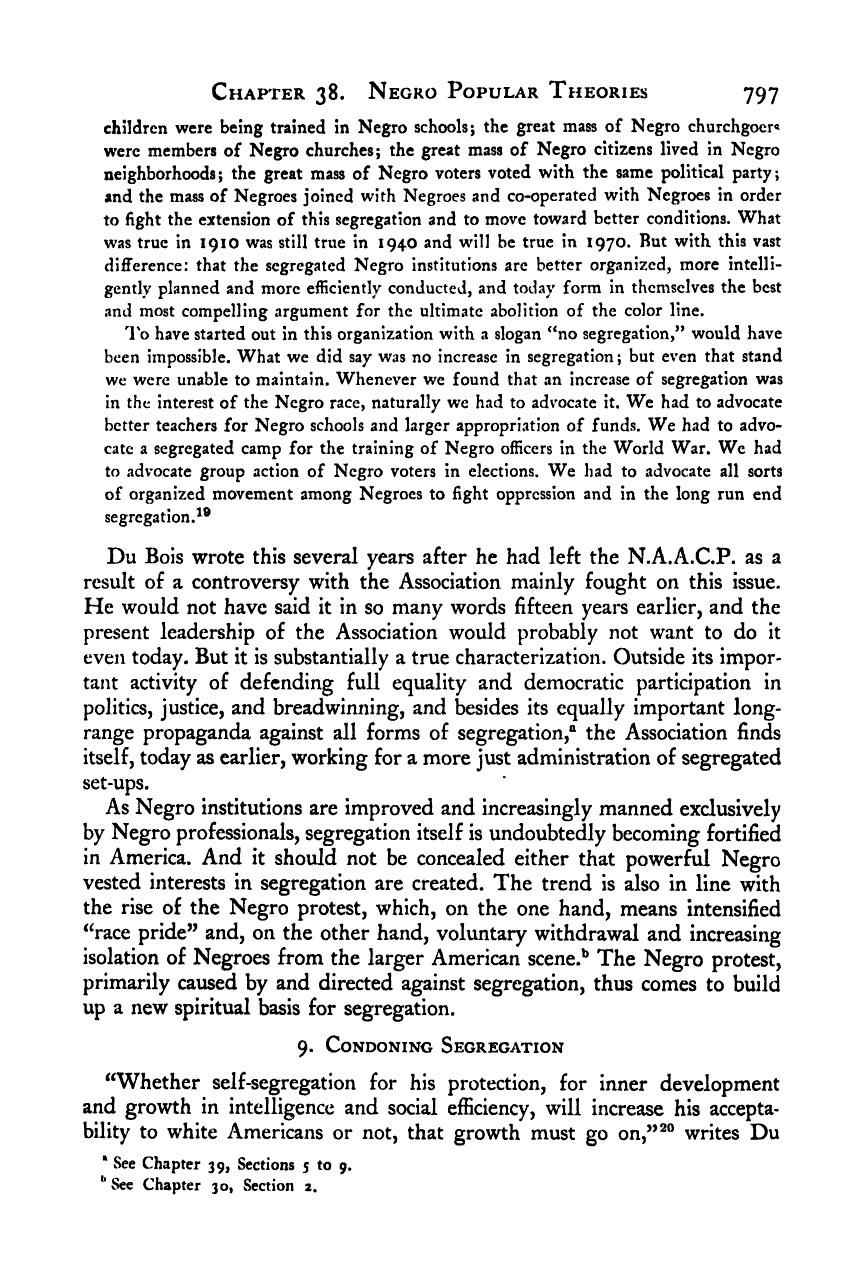Note: Gunnar Myrdal died in 1987, less than 70 years ago. Therefore, this work is protected by copyright, restricting your legal rights to reproduce it. However, you are welcome to view it on screen, as you do now. Read more about copyright.
Full resolution (TIFF) - On this page / på denna sida - IX. Leadership and Concerted Action - 38. Negro Popular Theories - 8. “The Advantages of the Disadvantages” - 9. Condoning Segregation

<< prev. page << föreg. sida << >> nästa sida >> next page >>
Below is the raw OCR text
from the above scanned image.
Do you see an error? Proofread the page now!
Här nedan syns maskintolkade texten från faksimilbilden ovan.
Ser du något fel? Korrekturläs sidan nu!
This page has never been proofread. / Denna sida har aldrig korrekturlästs.
Chapter 38. Negro Popular Theories 797
children were being trained in Negro schools; the great mass of Negro churchgoer^
were members of Negro churches; the great mass of Negro citizens lived in Negro
neighborhoods; the great mass of Negro voters voted with the same political party;
and the mass of Negroes joined with Negroes and co-operated with Negroes in order
to fight the extension of this segregation and to move toward better conditions. What
was true in 1910 was still true in 1940 and will be true in 1970. But with this vast
difference: that the segregated Negro institutions are better organized, more intelli-
gently planned and more efficiently conducted, and today form in themselves the best
and most compelling argument for the ultimate abolition of the color line.
I’o have started out in this organization with a slogan “no segregation,” would have
been impossible. What we did say was no increase in segregation ;
but even that stand
we were unable to maintain. Whenever we found that an increase of segregation was
in the Interest of the Negro race, naturally we had to advocate it. We had to advocate
better teachers for Negro schools and larger appropriation of funds. We had to advo-
cate a segregated camp for the training of Negro officers in the World War. We had
to advocate group action of Negro voters in elections. We had to advocate all sorts
of organized movement among Negroes to fight oppression and in the long run end
segregation.^®
Du Bois wrote this several years after he had left the N.A.A.C.P. as a
result of a controversy with the Association mainly fought on this issue.
He would not have said it in so many words fifteen years earlier, and the
present leadership of the Association would probably not want to do it
even today. But it is substantially a true characterization. Outside its impor-
tant activity of defending full equality and democratic participation in
politics, justice, and breadwinning, and besides its equally important long-
range propaganda against all forms of segregation,“ the Association finds
itself, today as earlier, working for a more just administration of segregated
set-ups.
As Negro institutions are improved and increasingly manned exclusively
by Negro professionals, segregation itself is undoubtedly becoming fortified
in America. And it should not be concealed either that powerful Negro
vested interests in segregation are created. The trend is also in line with
the rise of the Negro protest, which, on the one hand, means intensified
^^race pride” and, on the other hand, voluntary withdrawal and increasing
isolation of Negroes from the larger American scene.’^ The Negro protest,
primarily caused by and directed against segregation, thus comes to build
up a new spiritual basis for segregation.
9. Condoning Segregation
^^Whether self-segregation for his protection, for inner development
and growth in intelligence and social efficiency, will increase his accepta-
bility to white Americans or not, that growth must go on,”^® writes Du
<< prev. page << föreg. sida << >> nästa sida >> next page >>